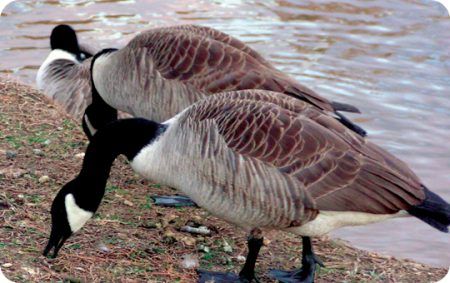Bird Feeders
Bird Food
Hardware
Nesting
Birds
Activities
Bird Feeding Solutions

Throughout history, Canada Geese have solely been a migratory species. For our ancestors, they were the definitive sign of the changing seasons as they passed overhead. To this day, a majority of Canada geese still migrate north in the spring to nest throughout Canada and Alaska and then return to the southern United States each autumn.
However, there has been a significant change in their migratory behavior during the past century. While there are still millions of migratory Canada Geese, a large number of non-migratory individuals are now year-round residents throughout much of North America. Unfortunately, these resident populations often create a wide range of problems in many urban settings.
How did a once noble bird become such a problem bird? It is the result of actions taken back in the early 20th century when the Canada goose populations declined as the result of habitat loss and the lack of hunting regulations. In an effort to increase their population, migratory Canada Geese were artificially introduced into numerous areas throughout the United States.
Since Canada Geese always return to nest in the area where they were born, the descendants of these introduced geese no longer had any biological need to migrate. As more and more generations of geese reproduced, and with a potential life span over 20 years, the population of these “resident” geese rapidly grew to abundant levels.
Overabundant Canada geese can cause problems because of their droppings, destruction of crops, gardens and lawns, and aggressive behavior. Canada geese can become more aggressive when they breed and nest in spring and summer. This is when the birds often come into conflict with people in urban areas.
Developers have created the perfect habitat for geese in areas with small ponds, gently sloping banks, and nicely groomed lawns. If you want to lower goose numbers in your area, you need to create a habitat that is not attractive to the geese.
Growing tall grasses, cattails or shrubs along the water creates a natural barrier for geese. Although geese can fly over these barriers, they often will move to a more appealing area. Biologists suggest planting a 20-foot to 30-foot strip of land along the water’s edge with native grasses and wildflowers, dense shrubs or ivy.
In some cases scaring the geese can deter them from staying or nesting in an area. You can also scare away geese by clapping your hands or chasing them, or even allowing Mylar balloons to sway in the wind a few feet off the ground. This practice usually works best when you do it before the geese become used to the area.
It is illegal to disturb or destroy nesting geese without a special permit.